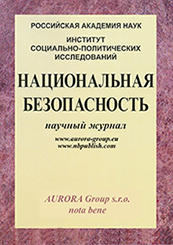Strategy of national security
Reference:
Begak M.V., Kodolova A.V., Pavlova M.V. (2016). Institutionalization of environmental safety and its support. National Security, 3, 309–318. https://en.nbpublish.com/library_read_article.php?id=67883
Abstract:
The subject of this research is the development of strategies of ecological security of the Russian Federation, and the object of this study is the Environmental Security Strategy of the Russian Federation until 2025, witin the the framework of the state program "Environmental Protection" for 2012 - 2020. The authors carefully examine such topics as the difference between the concepts of "environment" and "environmental security". Particular attention is paid to the definition of "environmental security" as a public institution that guarantees the prevention of unacceptable risks and harm to the environment and human health caused by environmental factors. Considered tools to ensure environmental safety of the country. The research methodology is based on an analysis of scientific papers of leading specialists in the field of ecological safety and environmental protection. Key findings of the study allowed us to formulate a new definition of environmental safety as some institutions providing prevention of environmental risk and as a consequence, harm. Because the risk is primary in relation to the harm can be defined as: Environmental security - a public institution that guarantees the prevention of unacceptable risks and harm to the environment and human health caused by environmental factors.
Keywords:
zero environmental risk, protection of the health of ecosystems, security strategy, improve safety, public institution, best available technology, environmental protection, environmental safety, self-regulating ecosystems, prevention of environmental risks
System and interaction
Reference:
Prokip A.V. (2016). Theoretical analysis of correlation between the energy and national security of the country. National Security, 3, 319–331. https://en.nbpublish.com/library_read_article.php?id=67884
Abstract:
The goal of this article is the determination of the role of energy security within the system of national security, its components and connection with other types of security from the positions of systematicity. The object of this research is the energy security of the country, while the subject is its structure, place within the system of national security and other types of security. The author carefully examines the links of energetics and energy security with various spheres of life and corresponding to them types of national security. The multidisciplinarity of the theory of energy security is being justified. Based on the analysis of energy sphere, as well as on the notion “energy security”, the author makes inductive conclusions about the structure of the sphere of state energy security and its correlation with the various types of security. The main result and conclusion of this research consists in the fact that energy security as a type of national security does not represent its separate independent part, but rather have been formed from the components of other types of security, namely economic, environmental, and social-political. Thus, the author determines that the system of indicator for the assessment of the level of energy security should be based on the assessment of the changes in these three spheres.
Keywords:
scientific and technical security, energy sources security, environmental security of energy supply, political security of energy supply, social security of energy supply, economic security of energy supply, energy security, national security, informational security of energy supply, Technetronic security of energy supply
Technologies and methodology of security systems
Reference:
Los' A.B., Tsaregorodtsev A.V., Sorokin A.V. (2016). Integrated approach to the construction of secure information and telecommunication systems based on hybrid cloud environment. National Security, 3, 332–337. https://en.nbpublish.com/library_read_article.php?id=67885
Abstract:
This article examines the issues of ensuring information security in the sphere of cloud technologies. Information and telecommunication systems, operating on the basis of cloud computing technology, over the recent years have become more widespread, with constantly growing needs in processing of the large volumes of data.The key point in the use of cloud computing is the issue of ensuring reliable protection of data during transmission, processing and storage. The article identifies the main problems of cloud computing from the point of view of information security and examines solutions when building complex systems of information protection in cloud architecture. In order too solve this issue, this work applies the method of theoretical analysis of the source data in various areas of the matter under consideration, the method of summarizing the results and formulating appropriate solutions. Scientific novelty of the work consists in a theoretical comprehensive analysis of this problem, including examination of threat to information in the cloud field, existing solutions in the specified direction and development on the basis of the results of the procedure for the comprehensive protection of cloud computing. Proposed applications of cloud computing for processing and storage of information of various categories, including critical assets. For working with such data, it is proposed to create a hybrid cloud environment, incorporating traditional cloud architecture elements of private clouds.
Keywords:
information risks, security requirements, information assets, information security management, information security threats, critical archives, private cloud, hybrid cloud, cloud computing, information and telecommunication systems
Rapid response and tactics
Reference:
Chuklina E.Yu. (2016). Situational prevention measures in the Russian theory of crime prevention. National Security, 3, 338–346. https://en.nbpublish.com/library_read_article.php?id=67886
Abstract:
The subject of the research is the specificity of criminological measures of situational crime prevention from the perspective of a Russian crime prevention theory. The article is devoted to theoretical reflection on space situational crime prevention measures in the modern crime prevention system. The peculiarities of situational crime prevention, recognized as one of the most popular in the world of criminal acts prevention strategies, are reported. It also discusses the concept and types of crime prevention. Particular attention is paid to the study of the relation of situational prevention measures and special criminological prevention of crime. The main research method in the article served as a comparative analysis of the characteristics of situational crime prevention and modern national crime prevention. The author's special contribution into this research should be recognized as proof of the integration of situational preventive measures in modern crime prevention system. The scientific novelty of this study lies in the fact that for the first time carried out in full theoretical understanding of space situational crime prevention in the Russian crime prevention system.
Keywords:
reducing crime motivation, security measures, secondary level of prevention, crime situation, special criminological prevention, crime prevention system, situational crime prevention, conditions of committing a crime, preventive practice, crime prevention theory
Transformation of national security systems
Reference:
Troshchinskiy P.V. (2016). The legislation of China in the sphere of fighting espionage and high treason: the historical and legal aspect. National Security, 3, 347–357. https://en.nbpublish.com/library_read_article.php?id=67887
Abstract:
The subject of research is the legislation of China in the sphere of fighting espionage and high treason. In this context the evolution of Chinese laws starting from the period of Ancient China up until present days is considered. During the whole period of statehood existence the counter-espionage service of China has recognized the fight against the acts of espionage and high treason as a matter of top priority. The Chinese “Art of War” of Sun Tzu has laid the theoretical foundation for it. According to the existing legislation, for the commission of the indicated crimes the perpetrator has been always submitted to the capital punishment. It was during the ancient times as well as during the periods of the Civil War, the Resistance against the Japanese Aggression and the years following the foundation of the People’s Republic of China. Nowadays death penalty for espionage and high treason still exists. Except the criminal code, the legal system of China contains the unique law “concerning fighting espionage” (was adopted in 2014). In 2015 the new law “concerning state security” was adopted. In 2013 in the system of the governmental authorities a new Central Committee on National Security evolved, it is responsible for fighting espionage and high treason. All the above stated indicates that within the scope of the research the Chinese state possesses the distinctive law-making experience, which represents an issue of great interest for the national science in the framework of comparative law.
Keywords:
Criminal responsibility, Counter-intelligence, Intelligence, Comparative legal studies, Death penalty, Legislation, Legal system, Treason, Espionage, China
Informational support of national security
Reference:
Zinov'eva E.S. (2016). The role of social media in contemporary international conflicts: the existing scientific approaches and future research directions. National Security, 3, 358–368. https://en.nbpublish.com/library_read_article.php?id=67888
Abstract:
The article is devoted to the analysis of the role of social media in contemporary international conflicts, as well as review of existing scientific approaches to the study of this new phenomenon.The author uses an interdisciplinary theoretical and methodological framework - the philosophy of technology and theories of political communication. The theory of political communication allows to analyze the characteristics of new media and their role in political communication in conflict, while the philosophy of technology makes it possible to assess the impact of technology on social processes, including international conflicts.As soon as the social media have become an integral part of the international policy and conflicts, the researchers are moving away from techno optimism in the evaluation of new Internet communications, according to which new media contribute to the democratization, the reduction of conflict, and consider the new media as a factor in the escalation conflicts, so techno pessimism becomes increasingly popular. At the same time, new media, like any other technology, are neutral and can be used by different groups for resolution as well as escalation of conflicts. However, studies on the role of social media in conflict resolution are underrepresented in the modern scientific literature. The author is proposes research agenda on the role of new media in the settlement of current conflicts.
Keywords:
international conflicts, world politics, internet, information security, conflict resolution, political communication, social networks, social media, philosophy of technology, conflict management
Internal aspects of national security
Reference:
Cherepanova M.I., Maksimova S.G., Nevaeva D.A. (2016). Regional aspects of national security: the assessment of interethnic tension in the boundary regions of Russia. National Security, 3, 369–380. https://en.nbpublish.com/library_read_article.php?id=67889
Abstract:
The subject of this research is the specificity of the ethno-national processes and the functioning of the ethno-national policy in the Russian boundary regions: Altai Krai, Orenburg Oblast, Zabaykalsky Krai, Jewish Autonomous Oblast, Kemerovo Oblast, Omsk Oblast, and Altai Republic. The object of this research is the evaluation of interethnic tensions in the context of regional aspects of national security. Special attention is given to the analysis of specificity of establishment of the intolerant attitudes towards the representatives of various ethnic groups residing in the regions, as well as to the description of the causes and factor which justify these attitudes. The authors present a model of social factors stimulating the interethnic tension in the general regional selection. Scientific novelty consists in determination of the regional data on social factors that provoke the increase of interethnic tension, as well as hinder the interethnic integration in boundary regions of the modern Russian society. The authors conclude that the socioeconomic factors and particularly of the domestic character, which affect the crisis of social development, namely the spread of corruption and bureaucracy, indirectly create e negative social background that forms the conditions for the increase of interethnic tension. Among the most weighty and statistically significant determinants became the presence and incidence of terrorist threat in the regions; hooligan actions based on interethnic conflicts; physical abuse; judgment of interethnic marriages; unfriendly expressions about the people of other faith. And the less significant are the prejudices that impede the establishment of friendly relations, as well as rivalry for leadership between the representatives of different nationalities.
Keywords:
Ethno-national policy, Terrorism, Interethnic conflict, Intolerance, Tolerance, Interethnic tension, Interethnic relations, National security, Nationalism, Ethnic identity
Internal threats and countermeasures
Reference:
Balynin I.V. (2016). Integral index of demographic development of the Russian regions: theoretical aspects and practical implementation. National Security, 3, 381–389. https://en.nbpublish.com/library_read_article.php?id=67890
Abstract:
The object of the study is the demographic policy as an important factor of the national security. The subject of the study is the demographic situation in the Russian Federation.The author examines in detail the demographic situation in the whole of the Russian Federation and in the regional context, the role of the mother justifies the capital as a method of improving the demographic situation in the Russian Federation.Particular attention is paid to the calculation of the integral index of the demographic development of the regions on the basis of the proposed methodology, developed taking into account the guidelines in the Decree of the President of the Russian Federation of 07.05.2012, and the concept of long-term socio-economic development of the Russian Federation for the period till 2020, Concept of the State Family Policy in the Russian Federation until 2025 and the Concept of Demographic Policy of the Russian Federation for the period up to 2025.The methodological basis is based on scientific methods, and in the special (financial, economic and statistics), as well as the principles of consistency and objectivity.The novelty of the study is the author of the proposed methodology for calculating the integral index of the demographic development of the Russian Federation to assess the demographic situation in the Russian regions.The practical significance of the research results is the possibility of their use for making concrete decisions on the modernization of social and economic processes of public authorities, as well as the use of student and faculty community in the educational process in higher and secondary special educational institutions.
Keywords:
regional development, maternal capital, population policy, national security, indexes, demographic situation, regions, demography, quality of life, lifetime
External aspects of national security
Reference:
Degtereva E.A., Sayapina K.V. (2016). Priority markets for Russian arms and military equipment in the BRICS countries. National Security, 3, 390–400. https://en.nbpublish.com/library_read_article.php?id=67891
Abstract:
The subject of this article is the current status of the military technology cooperation between Russia and the BRICS partners. In the first part of the article, the authors define the main principles of interaction between the BRICS member-states, as well as explain mutual interests and goals of the partnership. In the second part, the authors examine the macroeconomic environment of each of the BRICS member-states (the structure of supply and demand, current achievements in the sector of arms industry, key partners and most promising sub-branches). The third part of the article presents an analysis of the military technology cooperation between Russia and the BRICS countries for the purpose of determination of the most promising in the long-term perspective market niches, mutually beneficial for both sides in the context of each country. The authors explore the currently used financial mechanisms and schemes, such as export crediting, government insurance of export operations, offset obligations, compensation payments, direct financial aid, and leasing scheme. Currently, there is an understanding that activation of cooperation in the arms area has to be one of the key elements of collaboration within the BRICS block. There is a significant potential for increased volume of trade of medium and high technology products within the framework of the union, realization of joint investment projects in highly scientific fields, as well as exchange of experience in the area of improving the institutional component of the innovation sphere. Practical implementation of this potential will minimize the negative influence of the Western sanctions upon the Russian economy, as well as ensure the sustainable innovative-technological development of the country.
Keywords:
Arms technologies, Financial mechanisms, Export crediting, Offset obligations, Priority markets, Defense industry of Russia, National security, Armament, Military technology cooperation, BRICK block
External aspects of national security
Reference:
Pyatachkova A.S. (2016). Cooperation between China and the United States in maritime space of the Pacific Rim. National Security, 3, 401–407. https://en.nbpublish.com/library_read_article.php?id=67892
Abstract:
The article examines the cooperation between China and the United States in maritime space of the Pacific Rim; therefore the object of this research became the issue of maritime security in the Pacific Rim, while the subject is the collaboration between China and USA in this area. The work analyzes the notion of maritime security, influence of the key tendencies in the relations between PRC and USA upon their interaction in the area of maritime security, as well as their approaches towards understanding of this phenomenon. The research is based on the theory of neo-realism and systemic approach. The scientific novelty consists in the fact that the issue of ensuring security in maritime space of the Pacific Rim in the China-America relations is being comprehensively examined, taking into account the general tendencies and peculiarities of the development of this situation in the sphere of maritime activity in the context of relation between the People’s Republic of China and the United States. Maritime space is being views as a unified field of interaction (for example, in this context the problems of South China Sea and East China Sea are positioned as private cases of general tendencies). In the conditions of the growing competition for the regional leadership between PRC and USA, the cooperation between these two countries as the most influential actors in the Pacific Rim can either stabilize the situation in the area of maritime security, or worsen the already existing issues. At the same time, the maritime territorial disputes act as an instrument for establishing new order in the region, therefore, both sides use various means for supporting their presence in the region. Due to this fact, we can assume that the rivalry between China and the United States will remain.
Keywords:
Non-traditional threats to security, Piracy, Maritime activity, Maritime strategy of PRC, Maritime strategy of USA, Maritime territorial disputes, Problem of East China Sea, Problem of South China Sea, Maritime security, China-America relations
Humanitarian support of national security
Reference:
Przhilenskiy V.I. (2016). The logic of extremism: explanation vs. understanding . National Security, 3, 408–416. https://en.nbpublish.com/library_read_article.php?id=67893
Abstract:
The subject of this research is the specificity of extremist thinking, structure and contents of targeting of the extremist oriented individuals. The article examines extremism as a special type of attitude of an individual towards the processes and phenomena taking place in the surrounding world, in other words, in social, cultural, and ethno-confessional environment. The author explores the two types of main sources of the modern extremism (archaic and modern), by the reaction upon which the emotional and value-hued antagonism of the events encouraging individuals to search the way out from the situation in hand, are being determined. The author substantiates the thesis on the insufficient efficiency of classical means and methods of the analysis of specificity of the extremist thinking, such as historical materialism, positivism, and structural functionalism. The article presents two types of social techniques, with the help of which the modern world finds a “solution” of the problem of an individual and a group captured by the extremist attitudes. The author proves that there is a connection of these techniques with the spatial-temporal localization of values that unites the historical-geographical, ethno-confessional and sociocultural determinants of self-identification. The threats of the external interference into this process, as well as the need for the effective countermeasures against its manipulative technologization, are being demonstrated.
Keywords:
manipulation, identity, universal, unique, method, social tecniques, extremist thinking, modern, archaic, philosophical hermeneutics
Person and citizen within security systems
Reference:
Fedotova Yu.G. (2016). Classification of the form of citizen participation in ensuring national security and defense. National Security, 3, 417–427. https://en.nbpublish.com/library_read_article.php?id=67894
Abstract:
The subject of this research is the various forms of citizen participation in ensuring national security and defense. Based on the analysis of theoretical approaches towards determination of the forms of citizen participation in government administration, the article defines the historically substantiated and codified in the current Russian legislation main forms of citizen participation in defense of the country. Based on the characteristics of the modern military threats, the author detects the need for expansion of the forms of citizen participation in ensuring national security. The article establishes the unity of the forms of citizen participation in ensuring national security, presents their classification, as well as gives special attention to the demarcation of citizen participation that may or may not suppose inclusion into the ranks of a military organization in accordance with method of legal regulation of the corresponding public relations, legal status of citizens as the subject of legal relations and the character of mutual activity of the citizens and the authorized government bodies.
Keywords:
Participation, Defense, Security, Threat, Classification, Method of legal regulation, State military establishment, Interaction, Cooperation, Contribution
 This work is licensed under a Creative Commons Attribution-NonCommercial 4.0 International License.
This work is licensed under a Creative Commons Attribution-NonCommercial 4.0 International License.
 Eng
Eng












 © 1998 – 2025 Nota Bene. Publishing Technologies. NB-Media Ltd.
© 1998 – 2025 Nota Bene. Publishing Technologies. NB-Media Ltd.




